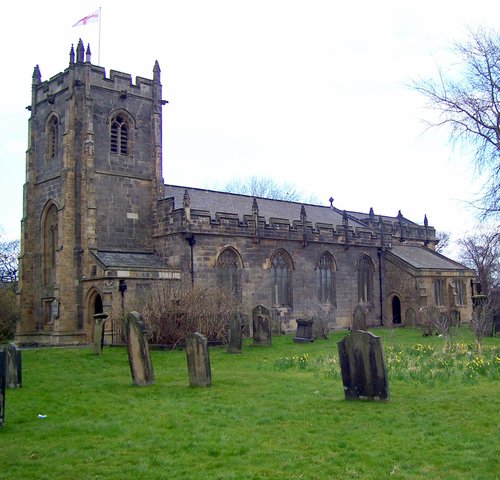
Whilst researching my Robson family, miners from Wallsend and Newcastle Upon Tyne, Northumberland, I came across the Russell Wallsend Mine disaster which occurred on 23 October 1821, nearly 200 years ago.
It took quite some time to piece together the history of the Robson family and in this quest I had an amazing collaboration with Sandy Murray, another Robson family researcher. It was Sandy who showed me how to find the Bishop’s Transcripts from Durham and Northumberland from FamilySearch.org, a free search engine which has generously uploaded some of the original Parish Registers to their website. The only proviso is that you have to know exactly what you are looking for and have the correct dates because it is a matter of slowly and carefully going through the registers page by page to identify your relatives.
Knowing that my 3x great grandfather Matthew Robson was married three times, twice in Northumberland, England and another marriage after his migration to Australia my work needed to be methodical. Matthew’s complicated family life made it even more important to correctly identify his wives and the children from each of these marriages. Much of this information I have already dealt with in my family chapter on The Robson Family of Northumberland, so I will not repeat any of that information, nor include the original records, I will simply provide a short summary, which shows how I came across a mining tragedy in our Robson family.
Matthew Robson was widowed in 1825 when his wife Margaret Robson nee Miller died after giving birth to her fifth child, also named Margaret. Margaret Robson was baptised on the same day as her mother was buried, 3 January 1825 and sadly she died 6 weeks later and was buried beside her mother on 25 February 1825 at St Peter’s Church Wallsend.
Just 4 months later Matthew Robson remarried a widow, Ann Davison at St John’s Church, Newcastle Upon Tyne on 20 June 1825. As I collected the baptisms for their 2 children, I decided that their son John Hutton Robson’s middle name must be significant. Perhaps this was Ann’s maiden name? I searched and found the marriage for Ann Hutton to Thomas Davison on 20 December 1813 at All Saints, Newcastle Upon Tyne, almost immediately I then found a the baptisms of their 4 children, William, James, Thomas and Thomasine at St Peter’s, Wallsend and then a burial record for Thomas Davison as well as the burial records for 2 of Ann Hutton’s brothers, William and John Hutton, all buried on the same day, 25 October 1821. I knew immediately that I had stumbled onto a most dreadful mining disaster and it took just a few seconds to confirm my fears about how shocking the disaster was, with 52 miners killed in a hydrogen gas explosion. Page after page in the St Peter’s burial register list the deaths of miners, including a 5 year old child, Samuel Garrett. Was Samuel the youngest child to ever die in a mining accident in England? In all, 5 children 12 years of age and under died in the explosion, along with 47 other miners.
I also realised that my ancestor Matthew Robson, a miner at Wallsend must have somehow escaped this fate; maybe he was not rostered on that day? Perhaps he did the night-shift and had just returned home or he worked in another mine nearby? It was also terribly sad to realise that poor Ann Davison was pregnant. Her daughter Thomasine Davison was baptised at St Peter’s Church, Wallsend on 22 April 1822, seven months after her father Thomas Davison was killed in the Russell Wallsend mining disaster on 23 October 1821.
I hope these original burial records may help other researchers to find their ancestors among these pages from the Burial Register of St Peter’s Church, Wallsend, Northumberland.
Burial Register from St Peter’s Church, Wallsend, Northumberland, 1813-1833,
25 and 26 October 1821, pages 95 to 101

Burial Register from St Peter’s Church, Wallsend, Northumberland 1813-1833, page 95

Burial Register from St Peter’s Church, Wallsend, Northumberland 1813-1833, page 96

Burial Register from St Peter’s Church, Wallsend, Northumberland 1813-1833, page 97

Burial Register from St Peter’s Church, Wallsend, Northumberland 1813-1833, page 98

Burial Register from St Peter’s Church, Wallsend, Northumberland 1813-1833, page 99

Burial Register from St Peter’s Church, Wallsend, Northumberland 1813-1833, page 100

Burial Register from St Peter’s Church, Wallsend, Northumberland 1813-1833, page 101

Newspaper account of the Russell Wallsend Mining Disaster, 1821, including The Names of all the Sufferers, image courtesy of Newcastle University Library
Few families suffered more in the aftermath of the tragedy than Mr Hutton’s house, where, “three of his friends lay dead on one bed.” These men were of course his two sons, William and John Hutton and his son-in-law Thomas Davidson (sic), his daughter Ann’s husband, made all the more tragic as she was expecting another child.
I decided to transcribe the list from the Wallsend, Northumberland Burial Register 1813-1833 finding fifty miners on the register which included old and young men, teenagers and young boys, aged from 5 years to 77 years, all who had died in the Russell Mine Disaster, 23 October 1821 and were buried in the churchyard of St Peter’s Church, Wallsend on 25 October 1821, after their funerals in the church. Two men were buried at St Peter’s Church the following day, 26 October 1821 and I have included them in my transcription. A George Roseby is listed in newspaper accounts as one of the victims. However, I have not seen any information on John Wake, only that he lived in the nearby township of Willington. John Elliott is not listed in the register and his burial place is unknown.
According to the Newcastle Times 30 October 1821, three miners apparently survived the explosion and two were most dreadfully burnt, and one survivor was now reported as dead. One man miraculously escaped unscathed, only to bravely return and help retrieve his fellow miners after the shocking hydrogen blast that shook the town of Wallsend on the Tuesday morning of 23 October. Some of the victims were buried at Wallsend Old Church and a few others taken to Ballast Hills (east of Wallsend near the mouth of the River Tyne) for burial. Not surprisingly newspaper accounts differ about who died and who survived and the aftermath of the explosion must have been chaotic. There are some newspaper accounts that list the names of the dead men, but even these lists contains anomalies as well as differing spellings of the miner’s surnames.
TRANSCRIPTION LIST OF THE PARISH BURIAL REGISTER OF ST PETER’S CHURCH WALLSEND, NORTHUMBERLAND 1813-1833 pages 95 to 101, October 1821
Page 95
758 James Kelley, Aged 20, son of William and Ann, Wallsend, bur. 25 Oct
759 Samuel Garret, Aged 5, son of Lowrey and Ann, Wallsend, bur. 25 Oct*
760 Christopher Wagget, Aged 31, Wallsend, bur. 25 Oct 9
Page 96
761 James Jopling, Aged 25, Wallsend, bur. 25 Oct*
762 John Norman, Aged 30, Wallsend, bur. 25 Oct
763 Robert Bowden, Aged 27, son of Robert and Isabelle, Wallsend, bur. 25 Oct
764 Henry Bowden, Aged 25, son of Robert and Isabelle, Wallsend, bur. 25 Oct*
765 George Thompson, Aged 12, son of Joseph and Alice, Wallsend, bur. 25 Oct
766 Nicholas English, Aged 32, Wallsend, bur 25 Oct
767 William Roddison, Aged 75, Wallsend, bur 25 Oct (Rodgerson)
768 Thomas Hoult, Aged 41, Wallsend, bur 25 Oct
Page 97
769 George Kyle, Aged 18, son of George and Sarah, Wallsend, bur 25 Oct
770 Robert Delap, Aged 25, Wallsend, bur 25 Oct
771 Robert Bainbridge, Aged 7, son of Robert and Jane, Wallsend, bur 25 Oct
772 Edward Campbell, Aged 35, Wallsend, bur 25 Oct
773 William Coxon, Aged 62, Wallsend, bur 25 Oct*
774 Roger Buddle, Aged 17, Wallsend, bur 25 Oct
775 John Smith, Aged 21, son of George and Elizabeth, Wallsend, bur 25 Oct
776 Henry Bowlam, Aged 77, Wallsend, bur 25 Oct
Page 98
777 Michael Moon, Aged 44, Wallsend, bur 25 Oct
778 Michael Moon, Aged 12, son of Michael and Jane, Wallsend, bur 25 Oct
779 Alexander Moon, Aged 8, son of Michael and Jane, Wallsend, bur 25 Oct*
780 Peter Hays, Aged 19, son of Peter and Jane, Wallsend, bur 25 Oct
781 John Ferry, Aged 26, Wallsend, bur 25 Oct
782 Thomas Wagget, Aged 34, Wallsend, bur 25 Oct
783 James Walker, Aged 22, son of Joseph and Jane, Wallsend, bur 25 Oct
784 William Smart, Aged 34, Wallsend, bur 25 Oct
Page 99
785 David Smart, Aged 31, Wallsend, bur 25 Oct
786 John Pendley, Aged 33, Wallsend, bur 25 Oct (Pendlington)
787 Thomas Lowrey, Aged 33, Wallsend, bur 25 Oct
788 William Bell, Aged 35, Wallsend, bur 25 Oct
789 William Bell, Aged 16, son of William and Margt., Wallsend, bur 25 Oct
790 William Jackson, Aged 21, son of James and Isabella, Wallsend, bur 25 Oct
791 Richard Hepple, Aged 55, Wallsend, bur 25 Oct*
792 Richard Hepple, Aged 17, son of Richard and Alice, Wallsend, bur 25 Oct
Page 100
793 George Pendley, Aged 50, Wallsend, bur 25 Oct, (Pendlington)
794 William Johnson, Aged 26, Wallsend, bur 25 Oct
795 John Johnson, Aged 23, Wallsend, bur 25 Oct
796 William Hutton, Aged 25, son of William and Jane, Wallsend, bur 25 Oct
797 John Hutton, Aged 22, son of William and Jane, Wallsend, bur 25 Oct
798 Thomas Davidson, Aged 36, Wallsend, bur 25 Oct
799 John Shotten, Aged 18, son of Andrew and Margt, Longbenton, bur 25 Oct
800 Edw. Shotten, Aged 20, son of Andrew and Margt, Longbenton, bur 25 Oct
Page 101
801 John Buckley, Aged 12, son of Thomas and Isabella, Wallsend, bur 25 Oct
802 John Gordon, Aged 20, son of John and Jane, Wallsend, bur 25 Oct
803 George Longstaff, Aged 46, Wallsend, bur 25 Oct
804 John Robinson, Aged 40, Wallsend, bur 25 Oct*
805 George Mason, Aged 21, Wallsend, bur 25 Oct*
806 George Roxby, Aged 31, Wallsend, bur 26 Oct* (survived explosion, badly burnt, listed in newspaper accounts as George Roseby)
49 Burials in this list from St Peter’s Parish Register, Wallsend
Notes:
* denotes miners listed on the Durham Mining Museum website who have not been listed as buried in the churchyard at St Peter’s Wallsend
All children in the burial register have their parent’s names included
I have transcribed the register as accurately as I could, the handwriting is faded and it is probable that the rector recorded some of the surnames phonetically, thus other historical lists and newspaper accounts will have varying spellings of the victim’s surnames and age discrepancies. I imagine Rev. George Jackson, the Rector of St Peter’s Church was overwhelmed by the tragedy; as well as his paper work, he was also ministering and comforting his grieving population, performing funerals and organising the burials.
Is 5 year old Samuel Garret, the son of Lowrey and Ann Garret, the youngest child to die in a mining accident in England? His father in not listed amongst the miners who died that day, however, was his uncle possibly another who was buried that day, Thomas Lowrey, aged 33?
Incredibly two very old miners, Henry Bowlam aged 77 and William Roddison aged 75 were amongst those who lost their lives at 8am on the morning of 23 October 1821 and were buried in St Peter’s churchyard.
Thomas Wagget, aged 34 is a brother to Christopher Wagget, aged 31. William Johnson aged 26 and John Johnson aged 23, were brothers. William Smart, aged 34 is a brother to David Smart aged 31.
Edward Coomby, Thomas Huggup, Richard Bell and William Johnson survived the explosion, explains Maureen Anderson in her book Northumberland and Cumberland Mining Disasters. Bell and Huggup apparently survived unscathed but Johnson succumbed just a few hours later, whilst Coomby lingered some days before his eventual death. This account differing to the newspaper report which claimed “Thomas Huggup, and Robt. Bell were severely burnt and are dangerously ill. Edw. Comby and Wm. Johnson escaped unhurt.”
William Johnson, aged 26, is listed in the St Peter’s Burial Register for 25 February 1821, Thomas Huggup and Richard/Robt. Bell appeared to the the only survivors. The severely injured Edward Coomby died some days later however he is not listed in the mining toll, nor is there a burial record to be found. There will probably always remain some confusion regarding the fate of those miners lucky enough to escape. Richard Bell’s father William Bell aged 33 (sic) and brother William Bell Jnr. aged 17 were victims, both are buried in the churchyard at St Peter’s, Wallsend.
Possibly no victim was more lamented by the villagers of Wallsend than their eminent and talented schoolteacher Thomas Hoult, listed as Thomas Holt in the newspaper account from the Newcastle University Library. Hoult was the mine wasteman, singled out along with Michael Moon and William Bell, the two mine overseers. A wasteman being a person employed to examine the state of the mine workings and to check that it is properly ventilated. In his spare time Hoult had “acquired a wonderful proficiency in Algebra, Fluxations and the higher branches of the Mathematics, accompanied with a competent share of general knowledge…” Hoult was also the Clerk of several Benefit Societies and his loss was even more keenly felt as he left a widow and a large family who were wholly unprovided for and it would seem that they would have to rely on charity to alleviate their sufferings.
William Russell, the colliery owner undertook to look after the reported 26 widows and 90 fatherless children for as long as necessary and he presented each family with a guinea to tide them over, plus the promise of two shillings a week to each affected widow and child. The colliery also paid the funeral and burial expenses for the miners. It was also a sad fact that some of the widows were expecting babies and their loss is unimaginable.
This was the fate that befell my own Robson family when Ann Davison nee Hutton, to add to the heart-breaking loss of her husband Thomas and two brothers, William and John Hutton and caring for her three fatherless children William, Jane and Frances, she found she was also pregnant with her fourth child, a daughter, who would never know her father. It was poignant that Ann Davison named this child Thomasina Davison after her dead husband Thomas. After her re-marriage to Matthew Robson, Ann named another son John Hutton Robson in honour of her dead brother.

Church pit, Wallsend, Newcastle Upon Tyne, circa 1830, Newcastle Library, image courtesy of Flickr
There were several other newspaper reports about the Russell Wallsend mining disaster. Some of them are heartrending with graphic accounts of the tragedy. The Newcastle Times ran two newspaper editions and The Westmoreland Times reported on the inquest.
“On Tuesday morning last, about 8 o’clock, another of those awful catastrophes which, within these few years, it has too often been our melancholy duty to mention, occurred at Carville colliery, near Newcastle. The pit had been re-opened for working about eight weeks, by the adjoining colliery of Wall’s End. The workmen employed in it had been selected as the very prime, from the whole of the extensive works of the owners, and the ventilation was considered as complete as that of any mine on the river. We understand that there is a band (i.e. a stratum of stone) in the coal, and that it was necessary to use candles in blasting it. However that maybe at the time above mentioned, when 55 persons were in the mine, an explosion of hydrogen gas took place, which killed 52 of them, dreadfully burnt two others, one of whom is since dead, and only one miraculously escaped unhurt. The explosion shook the ground like an earthquake, and made the furniture dance in the surrounding houses. The body of one boy was blown high out of the shaft, and fell again to the bottom. By this lamentable event 26 widows, and between 80 and 90 children, have been deprived of their support. Forty of the sufferers were under 40 years of age. It is a most remarkable circumstance, that one of them told his wife, before setting out to work on the fatal morning, that he dreamt the pit was blown up, and she affectionately entreated him not to go, but he said it was but a dream, and waved her advice. The man who escaped, in the course of an hour bravely ventured down again to the mine, to assist in bringing up his unfortunate companions. An inquest was on Wednesday held on the bodies by S. Reed, Esq., and the verdict was, that “the sufferers accidentally came to their deaths, by an explosion of hydrogen gas in the workings of the colliery.” On Thursday afternoon they were decently buried in Wall’s End church-yard, at the expense of the owners of the colliery, who presented each family with a guinea for present use, and will afford them houses, fuel, &c., as long as they many need them ; but we have little doubt that the benevolence of the public will on this, as on other occasions of a similar nature, step forward to alleviate, as far as pecuniary benevolence can alleviate, the anguish of this unhappy and long train of mourners.” Newcastle Times, 30 October 1821.
“On Tuesday morning last, soon after the pitmen connected with the Wall’s End Colliery, in the vicinity of shields, had gone to work, an explosion too place, supposed to have been occasioned by the injudicious use of a naked candle ; when, dreadful to relate, 50 men and boys were instantaneously killed in the pit, and 4 more so seriously injured, that one of them has since died, and the other 3 are yet in a very dangerous state.
As soon as possible, men were sent down to ascertain the extent of the evil ; and the dead bodies and lingering sufferers were drawn up in the corfs, and were conveyed away to their disconsolate widows and families in 10 carts. Some of the bodies were dreadfully disfigured ; but others had no marks upon them. The misery thus occasioned is incalculable, many of them having each left a widow and 5 or 6 children unprovided for. We cannot conclude this mournful account without remarking, that we hope the frequency of these lamentable occurrences will be the occasion of the immediate establishment of a fund for the relief of the widows and orphans occasioned by the present calamity, and of such as may hereafter fall victims to similar dreadful accidents.” Newcastle Times, 30 October 1821
“On Tuesday morning the 23d ult. about eight o’clock, another of those awful catastrophes which, within these few years, it has too often been our melancholy duty to mention, occurred at Carville colliery, near Newcastle-upon-Tyne. The pit had been re-opened for working, about eight weeks, by the owners of the adjoining colliery of Wallsend. The workmen employed in it had been selected as the very prime from the whole of the extensive works of the owners, and the ventilation was considered so complete as to render the use of Sir Humphrey Davy’s safety-lamp unnecessary. We understand, that there is a band (i.e. a stratum of stone) in the coal, and that it was necessary to use candles in blasting it. However that may be, at the time above mentioned, when fifty-six persons were in the mine, an explosion of hydrogen gas took place, which killed fifty of them, dreadfully burned four others, one of whom is since dead, and only two miraculously escape unhurt. The explosion shook the ground like an earthquake and made the furniture dance in the surrounding houses. The body of one boy was blown high out of the shaft, and fell again to the bottom. By this lamentable event forty-eight widows, and between eighty and ninety children, have been deprived of their support. Forty of the sufferers were under 40 years of age. “Never,” says an eye-witness, “saw I scenes so awful as when going, the next day, from one house of mourning to another. Fathers lying by their sons, brother by brother ; mothers bewailing their sons and sons-in-law, wives their husbands, and children their fathers or their brothers ; every house seemed full of woe. The bodies of the unfortunate victims were miserably burnt; and, together with the distress of their surrounding relatives, formed so horrifying a reality, as soon to exhaust my spirits and my strength, and compel me to quit a scene so full of heart-rending and dreary desolation.” It is a most remarkable circumstance, that one of the sufferers told his wife, before setting out to work on the fatal morning, that he had dreamt the pit was blown up, and she affectionately entreated him not to go; but he said it was but a dream and waved her advice. One of the men who escaped, in the course of an hour bravely ventured down again to the mine, to assist in bringing up his unfortunate companions. An inquest was, on Wednesday, held on the bodies, by S Reed Esq. and the verdict was, that “the sufferers accidentally came by their deaths, by an explosion of hydrogen gas in the workings of the colliery.” Thursday afternoon they were decently buried in Walls End Churchyard, at the expense of the owners of the colliery, who presented each family with a guinea for present use, and will afford them houses, fuel, &c as long as they may need them ; but we have little doubt that the benevolence of the public will, on this, as on other occasions of a similar nature, step forward to alleviate, as far as pecuniary benevolence all alleviate, the anguish of these unhappy mourners.” Westmorland Gazette, 3 November 1821
The Durham Mining Museum Website, which lists these three previous newspaper transcriptions is an excellent source of information about mining disasters in Durham and Northumberland. A wonderful feature is an interactive wall where people can leave condolence messages or provide mining information about the families and descendants of miners who died in mining accidents.
A contributor to the Durham Mining Museum website wrote a memorial about some of the victims of the Russell Wallsend Mine, explaining that George Pendlington (50) was born in Longbenton in 1772 and married Margaret Hepple. George Pendley (sic) is listed in the parish burial records and was buried at St Peter’s Wallsend. She corrects the listing of his name as George Pendlington not Pinkley and that of his nephew John, on the Durham Mining Museum Website. George is buried in a family grave together with his brother-in-law Richard Hepple (55), Richard’s son Richard Hepple (17) Jnr, his son-in-law Nicholas English (32) and two other brothers, William Johnson (26) and John Johnson (23). A nephew, John Pendlington (33) who died in the mine that day is also buried in the churchyard – I have listed these men’s ages as they are recorded in the burial record.
In collaboration recently with Sandra Pendlington, she pointed out that William Rogerson (75), listed in the parish records as Roddison, was the grandfather of William Jackson (21), asking, is this the only instance of a grandfather and grandson being killed in a mining disaster?
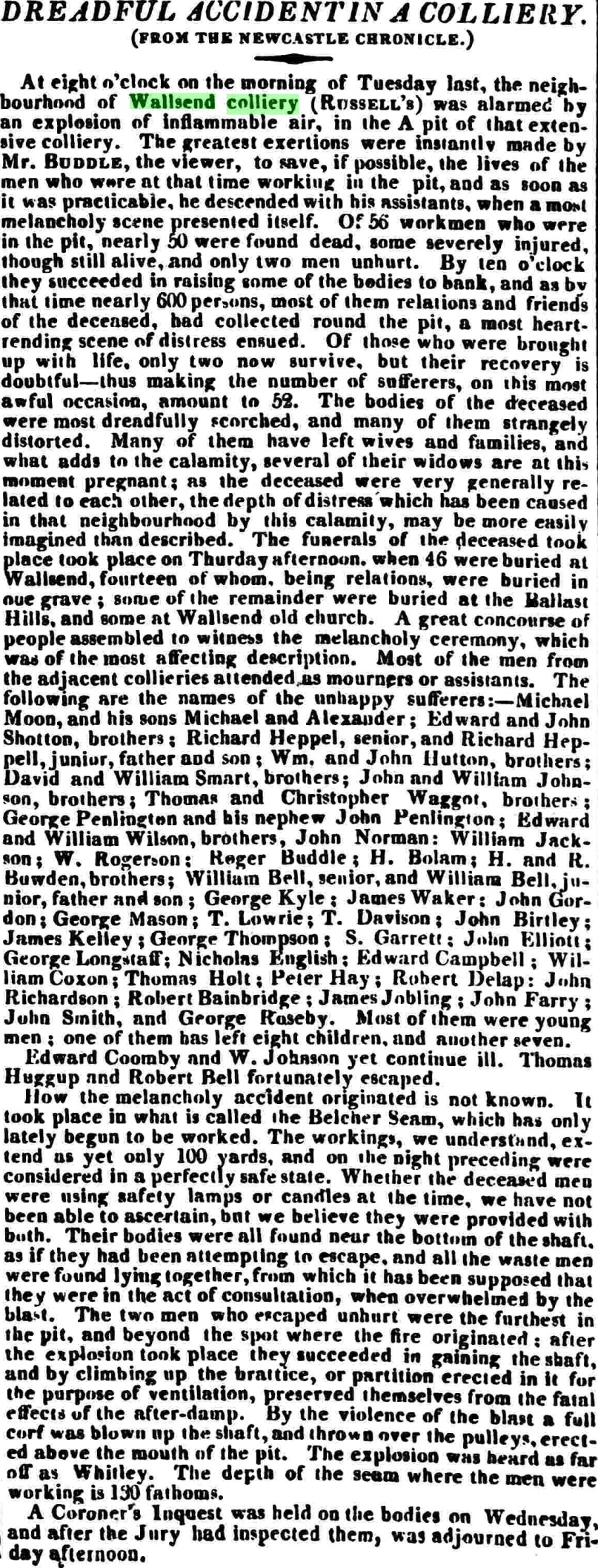
The Morning Post (London) 30 October 1821
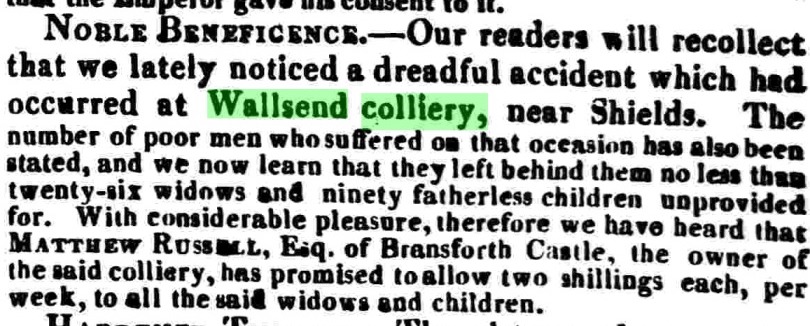
The Morning Post (London) 29 November 1821
Soon after I heard from Sandra Pendlington, I was sent a message from St Peter’s Church warden informing me that they are organising a memorial service at 10am on Saturday 23 October 2021 to commemorate the mine victims. A plaque will be unveiled, however no names will be on it. They are hoping to see family members on the day.
I am so pleased to be able to include a photograph of the plaque commemorating the 200 year anniversary of the Russell Wallsend Mine disaster, which has been kindly photographed and sent to me by Sandra Pendlington.
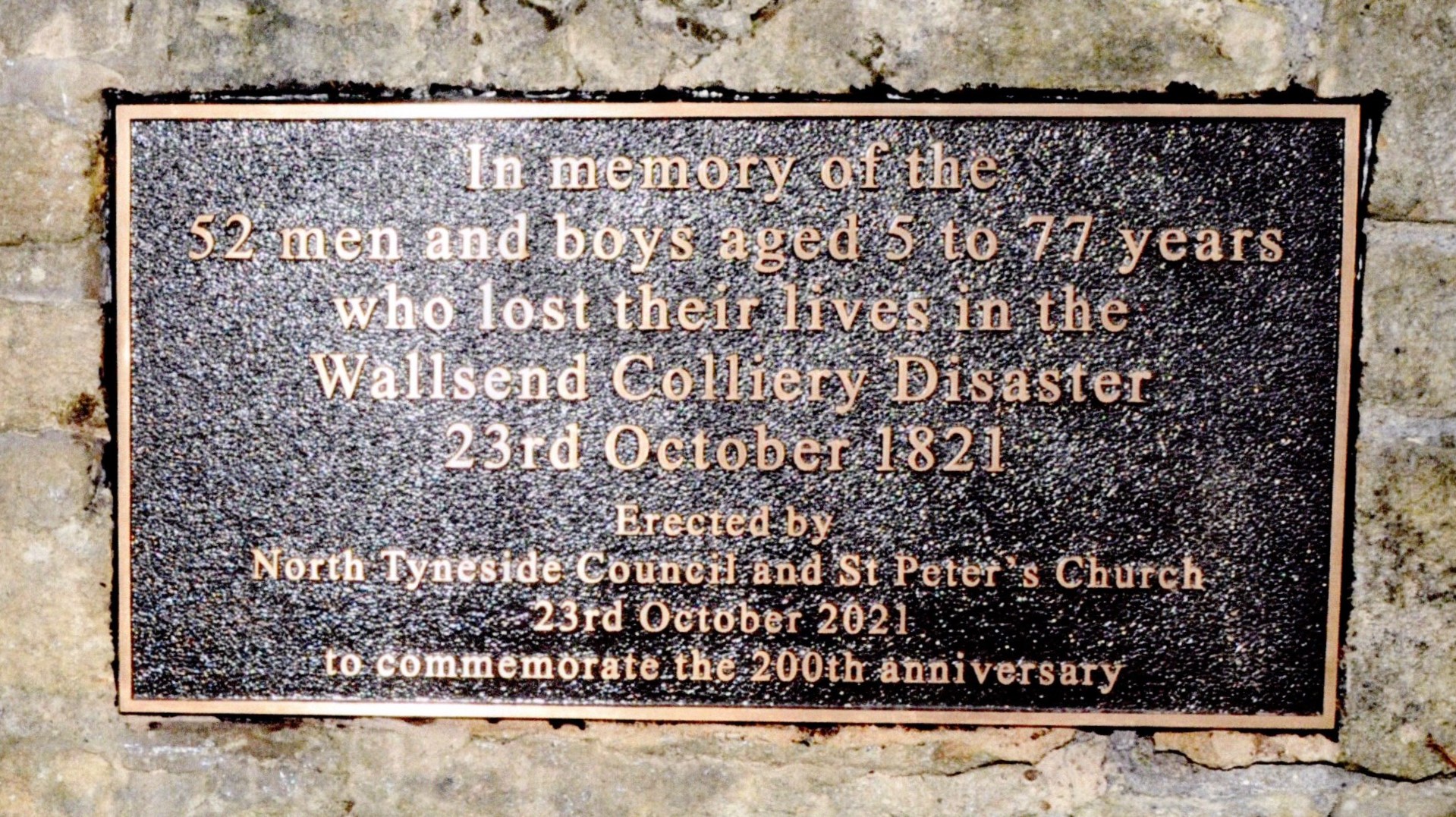
I hope to hear from others whose ancestors died in Russell Mine, Wallsend in 1821 and will happily include their accounts and update this chapter of my website as an enduring Memorial to the miners who died in the mine explosion.
Virginia Rundle
21 May 2020, updated 4 October 2021
MEMORIALS
Sandra Pendlington kindly shared her tragic family story about this mining disaster. She also pointed out to me that next month marks the 200 year anniversary of the Russell Mine explosion and poignantly her family will gather at the Pendlington grave, St Peters, Wallsend to commemorate and remember the occasion.
“Our family lost at least 7 men in this disaster. George Pendlington (record 793), both his sons-in-law William Johnson (rec. 794) and Nicholas English (Rec 766), his nephew John Pendlington (rec 786), his wife’s brother Richard Heppell Sr (Rec 791) and his son Richard Heppell Jr (Rec 792), William’s brother John Johnson (Rec 795), uncle William Coxon (Rec 773) and my husband 5 x great grandfather William Rodgerson (Rec 767). The Pendlington grave in Wallsend Church yard is the only reminder of this tragedy because there is no plaque. On the 23 Oct the family will gather to commemorate the 200th anniversary and remember all those who died and we are hoping to get permission for the names of those who died to be displayed somewhere.
I will add that Nicholas English’s son John and John Pendlington’s son Ralph were killed in the much bigger Wallsend C disaster of 1835. William Rodgerson’s great grand son Benjamin Pendlington is the first known casualty of coal mining in Indiana USA. King Coal has taken many lives.” Sandra Pendlington, 30 September 2021
I’m a descendant of William Roddison who you have correctly deduced was more properly named William Rodgerson. He was in fact the step grandfather of William Jackson rather than the biological grandfather. William married a widow Jane Jackson in 1776. Jane is the grandmother of William Jackson. The Northumberland and Durham Family History Society can provide a photo of the gravestone of both Williams. I fear it is no longer standing because the photo shows it lying on the ground. Nick Redheaf 23 October 2021
Bibliography:
FamilySearch.org for Bishops Transcript Burial Register from St Peters, Wallsend
Durham Mining Museum website
Wikitree, Russell’s Pit Colliery Explosion
Northumberland and Cumberland Mining Disasters by Maureen Anderson
Ancestry.com
Special thanks to Sandy Murray for her research help on the Robson Family History
Newcastle Library and Flickr.
Geograph Photos
Old English Newspapers from online resources at the Australian National Library accessing Gale Primary Sources at British Library Newspapers
Newcastle University Library, Newcastle Upon Tyne
Thanks also to Sandra Pendlington for her contributions regarding her ancestors


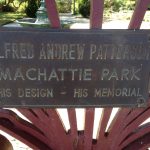

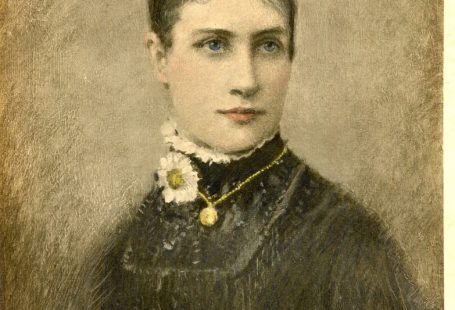
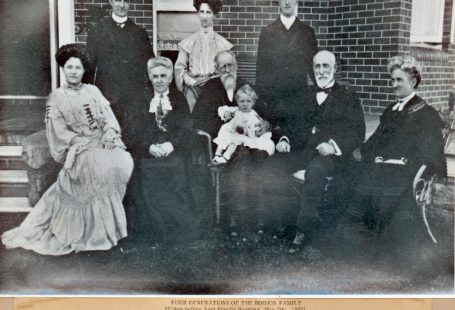
4 comments On Russell’s Wallsend Mine Disaster, Wallsend, Northumberland, England, 23 October 1821
Our family lost at least 7 men in this disaster. George Pendlington (record 193), both his sons-in-law William Johnson (rec. 194) and Nicholas English (Rec 166), his nephew John Pendlington (rec 186), his wife’s brother Richard Heppell Sr (Rec 191) and his son Richard Heppell Jr (Rec 192), William’s brother John Johnson (Rec 195) and my husband 5 x great grandfather William Rodgerson (Rec 167). The Pendlington grave in Wallsend Church yard is the only reminder of this tragedy because there is no plaque. On the 23 Oct the family will gather to commemorate the 200th anniversary and remember all those who died and we are hoping to get permission for the names of those who died to be displayed somewhere.
I will add that Nicholas English’s son John and John Pendlington’s son Ralph were killed in the much bigger Wallsend C disaster of 1835. William Rodgerson’s great grand son Benjamin Pendlington is the first known casualty of coal mining in Indiana USA. King Coal has taken many lives.
Hello my name is Mavis I am the churchwarden of St Peters Church Wallsend and would like to inform your family we have organised a service at 10 on Saturday 23rd of Oct to commemorate the vjctims we are unveiling a plaque but unfortunatly no names will be on it We hope to see family members on the day. Best wishes. Mavis
Hello. I’m a descendant of William Roddison who you have correctly deduced was more properly named William Rodgerson. He was in fact the step grandfather of William Jackson rather than the biological grandfather. William married a widow Jane Jackson in 1776. Jane is the grandmother of William Jackson. The Northumberland and Durham Family History Society can provide a photo of the gravestone of both Williams. I fear it is no longer standing because the photo shows it lying on the ground.
Thanks you for this piece of research I am 4x GG son of Thomas Wagget who perished in 1821 he and his brothers father Ralph aged 70 was also lost in the 1835 disaster together with two of his grandsons
thankfully we live in safer times…
KR